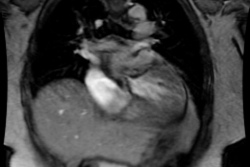Mahnken AH, Wildberger JE, Simon J, Koos R, Flohr TG, Schaller S, Gunther RW.
OBJECTIVE: The purpose of this study was to assess the applicability of individual body weight-adapted tube current time settings in multidetector CT for detection of coronary calcifications and to evaluate the effect of reducing the radiation dose on the coronary calcium score. SUBJECTS AND METHODS. One hundred patients underwent retrospectively ECG-gated MDCT for detection of coronary calcifications. First, fixed tube current time settings were used in 50 patients. Second, image noise corresponding to body weight-adapted tube current time settings was added to these images. Finally, body weight-adapted tube current time settings were applied to another 50 patients. For each patient group, the radiation dose was calculated. Coronary calcium scores were compared for the patient groups with the fixed tube current time settings with and without artificially added image noise. In all image series, image noise was assessed by a region-of-interest methodology. Image noise was analyzed using a regression analysis. RESULTS: The effective radiation dose was reduced by 11.6% for men and 24.8% for women using the body weight-adapted tube current time settings. There were no statistically significant changes in the coronary calcium score after the addition of artificial image noise (p = 0.84). Adaptation of the tube current time settings did not lead to a relevant increase in image noise. The radiation doses for the plotted noise-to-body weight (slope, 0.081) and noise-to-body mass index (slope, 0.378) ratios for the standard protocol proved relatively high for patients of lower weight. An improved noise-to-body weight (slope, 0.054) and noise-to-body mass index (slope, 0.190) ratio was achieved by application of the body weight-adapted tube current time settings, resulting in nearly constant image noise related to body weight. CONCLUSION: Individual body weight-adapted current time settings are applicable for coronary calcium scoring without a change of the coronary calcium score or relevant increase of the image noise.





